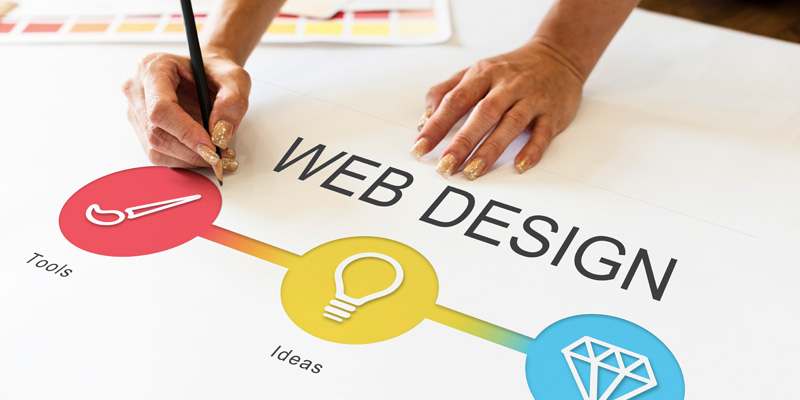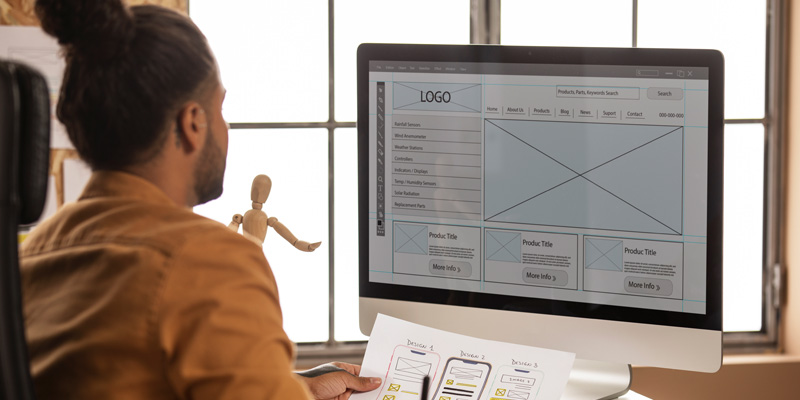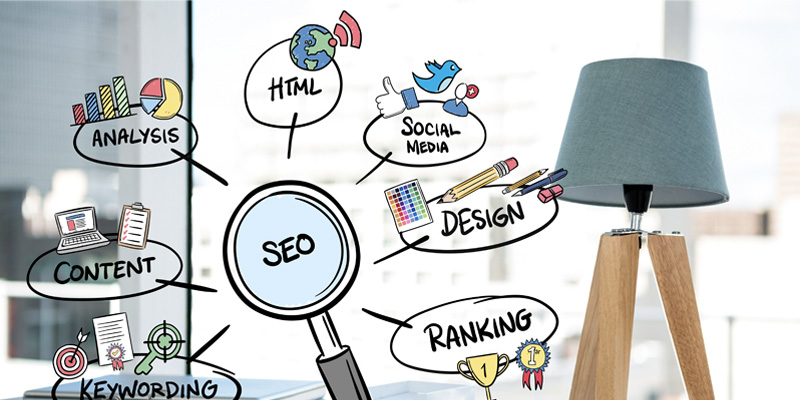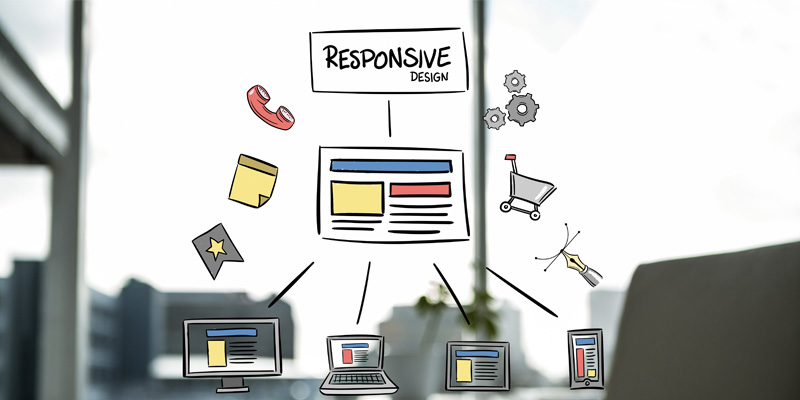Choosing the Right Web Design Company: Why It Matters
Ever landed on a site and thought, “Wow, that’s sleek”? That’s the power of great web design. But it’s more than just looks—it’s about functionality and user experience. In this guide, you’ll discover the significance of professional design, learn to sidestep common selection pitfalls, and grasp the essentials of SEO-integrated designs. From key questions to ask to budgeting insights, let’s ensure your business shines online.
Reading Time: 13 Minutes
1. Introduction to Web Design

1.1. Why a Professional Web Design Matters
Let’s paint a picture. You walk into a brick-and-mortar store, and it’s cluttered, dimly lit, with no signs guiding you. Frustrating, right? Now, consider a website. Your digital storefront. If it’s disorganized, slow, or hard to navigate, that’s the online equivalent of the messy store. It’s off-putting.
Professional web design is about creating an online space where your visitors feel welcomed. It’s your digital handshake, your first impression. And in today’s digital age, a fraction of a second can make or break that impression.
Here’s a nugget for you: according to the Gomez report, 88% of online visitors are less likely to return after a poor website experience. This isn’t just about aesthetics; it’s about functionality, ease of use, and how your site performs on various devices.
A professionally designed website does three critical things:
- Boosts Credibility: Whether you’re a startup or an established brand, a well-crafted website elevates your legitimacy. In an era where scams are rampant, appearing professional and trustworthy is paramount.
- Enhances User Experience: A site that’s intuitive and user-friendly keeps visitors engaged. They find what they need quickly and might even linger, increasing the chances of conversions.
- Optimizes Load Time: Slow sites kill conversions. It’s not enough for a website to look good; it needs to function swiftly. A streamlined, professionally designed site ensures faster load times, which is crucial for keeping potential clients or customers on board.
1.2. The Evolution of Web Design Practices
Journey back a couple of decades, and web design was, let’s just say, rudimentary. Think basic colors, pixelated images, and clunky navigation. Fast forward to today, and it’s a whirlwind of dynamism, responsiveness, and interactivity. It’s an ever-evolving landscape, and keeping pace ensures you don’t get left in the digital dust.
A quick snapshot of the evolution:
- From Static to Dynamic: Early websites were static, meaning content remained unchanged unless manually edited by someone. Today’s sites are dynamic, updating in real-time and providing interactive experiences to users.
- The Rise of Mobile Design: With over 50% of global website traffic generated from mobile devices, it’s no wonder that responsive design has become the standard. A site needs to look as polished on a smartphone as it does on a desktop.
- Parallax Scrolling: This modern design technique involves the background moving slower than the foreground, creating a 3D effect. It’s visually engaging and has been a favorite in recent years.
- Flat Design to Material Design: Flat design, with its minimalist use of simple elements and bright colors, dominated the scene for a while. Then came Google’s Material Design, which added some depth and shadow, blending the best of both worlds.
- AI and Chatbots: More websites now incorporate AI-driven chatbots, improving user engagement and automating customer service queries.
Why should you care about these shifts? Well, it’s not just about being trendy. These evolutions reflect user behavior, technological advancements, and efficiency improvements. Aligning your website with contemporary practices ensures relevance, better engagement, and, ultimately, higher conversion rates.
1.3. Understanding User Experience (UX) and User Interface (UI)
Picture this: You enter a swanky new cafe. The decor (UI) is appealing, but the waiter’s attitude (UX) leaves much to be desired. The takeaway? Both ambiance and service matter.
In the digital realm:
- User Interface (UI): It’s the look and feel of your website—the colors, the buttons, the graphics, the typography. A pleasing UI captures attention, making visitors want to explore more.
- User Experience (UX): It’s the interaction bit. How easy is it to navigate your website? Do the call-to-action buttons lead where they should? UX ensures a smooth, intuitive journey for your users.
- A great UI without a solid UX is like a book with a beautiful cover but confusing content. The opposite holds true as well. The trick is to strike a balance:
- Consistent Design: Keep fonts, colors, and design elements consistent. It offers a cohesive experience and strengthens brand recognition.
- Clear Navigation: Your site’s navigation should be intuitive. If visitors can’t find what they’re looking for quickly, they’re likely to bounce.
- 6. Fast Loading Times: Speed matters. A delay of just a few seconds can see potential customers clicking away.
- Feedback Mechanisms: Whether it’s a form submission acknowledgment or a user rating system, feedback assures users that their actions have results.
The blend of optimal UI and UX can skyrocket engagement rates, making your visitors feel valued and understood. And in the digital age, that’s the name of the game.
2. Key Features

2.1. Portfolio and Proven Track Record
Ever heard the saying, “Seeing is believing?” In the world of web design, a company’s portfolio is its visual resume. It showcases the breadth and depth of their expertise, their design style, and their versatility across industries.
What to Look for:
- Variety of Projects: This shows flexibility and adaptability.
- Testimonials and Case Studies: These offer insights into the company’s collaboration style and the results they’ve delivered.
- Updated Work: A continuously updated portfolio indicates that they’re keeping pace with evolving design trends.
2.2. Technical Expertise and Tools
Sure, a design might look appealing, but what’s under the hood? The technical prowess of a web design company is as vital as their creative flair.
Key Points of Consideration:
- Frameworks and CMS: Are they familiar with popular platforms like WordPress, Joomla, or Drupal?
- Custom Solutions: Can they provide tailor-made solutions or only work with templates?
- Integration Skills: How adept are they at integrating third-party tools or platforms into the design?
2.3. Attention to the Latest Design Trends
While trends shouldn’t dictate the entirety of your website’s design, being aware of them indicates a company’s commitment to modernity.
Stay Updated with:
- Responsive and Adaptive Design: As mentioned, mobile optimization is non-negotiable today.
- Use of AR and VR: With advancements in technology, immersive experiences are becoming more prevalent.
- Micro-Interactions: These are tiny animations that make interactions delightful, like a unique hover effect or an engaging loading animation.
2.4. Comprehensive Services Beyond Design
Web design doesn’t exist in isolation. It’s part of a broader digital ecosystem, and the best web design companies understand this interconnectedness.
Explore their Offerings:
- SEO Services: This ensures your site isn’t just beautiful, but also discoverable.
- Content Creation: Content is king. Can they help craft compelling copy that aligns with the design?
- Maintenance and Support: A website isn’t a set-it-and-forget-it tool. Regular updates and troubleshooting are part and parcel of its lifecycle.
3. Mistakes to Avoid

3.1. Overlooking the Importance of Responsiveness
Imagine your website looking stellar on a desktop but turning into an absolute chaos on a mobile device. Not the image you’d want, right? With mobile internet usage surpassing desktop, responsiveness isn’t a luxury—it’s essential.
Key Takeaways:
- Test on Multiple Devices: Ensure the company tests designs on various devices and screen sizes.
- Prioritize Mobile-First Design: With search engines like Google prioritizing mobile-optimized websites, it’s vital to design with mobile users in mind.
3.2. Not Checking Client Testimonials and Reviews
It’s like skipping a movie’s reviews and then being shocked that it wasn’t up to par. Client feedback can provide a wealth of information about a company’s work ethic, professionalism, and results.
Points to Ponder:
- Look Beyond the Company’s Website: Sites like Clutch, Glassdoor, or even Google can provide unbiased reviews.
- Reach Out to Previous Clients: If possible, a quick chat can offer in-depth insights into their experience.
3.3. Making Cost the Only Deciding Factor
Sure, budgeting is essential, but remember the age-old saying, “You get what you pay for.” Going for the cheapest option might save some pennies now but can cost you in the long run.
Financial Foresight:
- Value Over Price: Assess what you’re getting for the price. Comprehensive services might seem expensive but can offer better value in the bigger picture.
- Avoid Hidden Costs: Ensure transparency in pricing. Understand all costs involved, from design to maintenance.
4. The Importance of SEO

4.1. Why SEO Should Be Integrated from the Start
Think of your website as a swanky new store. Now, SEO is the signboard that tells people how to find it. Integrating SEO from the get-go ensures your site doesn’t just look good but gets the visibility it deserves.
Considerations:
- Optimized Code and Site Structure: A well-structured website with clean code can improve search engine rankings.
- Keyword-Optimized Content: It’s vital to ensure that the site’s content is crafted with relevant keywords in mind, but without keyword-stuffing.
4.2. Features of SEO-Friendly Design
An SEO-optimized design goes beyond just plugging in keywords. It encompasses site architecture, loading speed, meta tags, and more.
Key Features:
- Fast Loading Times: Search engines favor sites that load quickly.
- Mobile Optimization: A mobile-friendly design improves rankings, especially after Google’s mobile-first indexing.
- Optimized Images and Media: Ensuring media elements are appropriately formatted and sized can enhance SEO while improving user experience.
4.3. Collaboration Between Designers and SEO Specialists
A symphony when the orchestra plays in harmony. Similarly, a seamless collaboration between designers and SEO experts can amplify your website’s effectiveness.
Synergising Efforts:
- Unified Goal Setting: Both teams should align on the site’s primary objectives.
- Open Communication: Regular touchpoints can ensure that design choices support SEO strategies and vice versa.
5. Questions to Ask

5.1. Inquiries about Their Design Process
You wouldn’t dive into a project without a game plan, right? Understanding a company’s design methodology can give you insights into their approach and how your project will be handled.
Questions Worth Asking:
- What steps do you follow from conceptualization to completion?
- How do you prioritize user experience in your design process?
- Do you start with wireframes or mockups? Can clients be involved in this phase?
5.2. How They Handle Feedback and Revisions
Feedback is the bridge between the initial design and the final product. Knowing how a company handles this critical phase can avoid potential bottlenecks later on.
Suggested Queries:
- What’s your revision policy? How many rounds of changes are included?
- How do you prefer to receive feedback, and how quickly can revisions be made?
- If we disagree on a design choice, how is that resolved?
5.3. Their Approach to Mobile Design
In today’s digital age, where mobile browsing often surpasses desktop, this aspect is non-negotiable.
Dig Deeper with:
- How do you ensure a site’s mobile responsiveness?
- What challenges have you faced with mobile design and how did you overcome them?
- Do you design with a mobile-first or desktop-first approach?
5.4. Timeline and Project Management Methods
A project without a timeline is like a ship without a compass—you’re bound to get lost. Clarity on this front can set the right expectations.
Inquisitive Points:
- What’s the estimated timeline for a project like ours?
- How do you track project milestones, and will we have visibility into progress?
- Who will be our main point of contact throughout the project?
6. Evaluating Your Budget and Needs

6.1. Understanding Pricing Models
Money talks, but it’s essential to understand the language. Dive into the nuances of how web design companies price their services to ensure you’re getting bang for your buck.
Clarifications to Seek:
- Do you charge a flat rate, hourly, or based on project milestones?
- What’s included in the quoted price, and are there potential additional costs?
- How are overages or out-of-scope requests handled?
6.2. Hidden Costs and Overhead to Watch Out For
The devil is often in the details. Unearthing any potential hidden costs can save you from unwelcome surprises down the line.
Red Flags to Look Out For:
- Hosting or domain registration fees that weren’t discussed upfront.
- Charges for essential plugins or third-party integrations.
- Post-launch support or maintenance fees that weren’t explicitly mentioned.
6.3. Getting the Best Value for Your Investment
A website is an investment, not an expenditure. Ensuring you get maximum ROI is paramount.
Evaluative Measures:
- Comparing portfolios of various companies in similar price brackets.
- Checking if the company offers post-launch analytics or performance tracking.
- Ensuring that the design aligns with your brand and business objectives, rather than just being aesthetically pleasing.
Remember, in web design, as in most things, value doesn’t always equate to the lowest price. It’s about ensuring that every dollar spent brings you closer to achieving your business goals.
7. Maintaining and Updating

7.1. The Importance of Ongoing Maintenance
You wouldn’t buy a car and never service it, right? Websites, similarly, need regular maintenance to ensure optimal performance.
Must-Knows:
- Security Updates: With the evolving landscape of cyber threats, keeping your website secure is paramount.
- Regular Backups: Accidents happen. Regular backups ensure that you can quickly restore your website in case of mishaps.
- Plugin and Software Updates: Keeping these updated ensures compatibility and smooth website operations.
7.2. Working with the Design Company Post-Launch
The relationship shouldn’t end post-launch. Having a reliable ally can make ongoing website management smoother.
Considerations:
- Support Contracts: Some companies offer maintenance packages. This could be a boon, especially if you lack in-house expertise.
- Feedback Loop: How easy is it to get in touch for minor tweaks or changes? Do they offer dedicated post-launch support?
- Training: If you have an in-house team, does the design company provide training on the CMS or platform used?
7.3. Ensuring Future Compatibility and Functionality
The digital world is ever evolving. Ensuring your website remains functional and up to date is crucial for sustained success.
Steps to Stay Ahead:
- Browser Compatibility: Regularly test your website across various browsers to ensure consistent performance.
- Adapting to Tech Trends: From VR to voice search, new trends emerge. Being adaptable ensures your website remains relevant.
- Periodic Audits: Conducting technical and UX audits can highlight areas for improvement.
8. Conclusion: Making the Final Decision

8.1. Trusting Your Instincts and Research
Data and research are essential, but sometimes, you’ve got to trust your gut.
Guiding Principles:
- Cultural Fit: Does the company vibe with your brand and values? This can impact the overall collaboration.
- Look Beyond the Portfolio: Sure, past work matters, but also consider their enthusiasm, vision, and understanding of your unique needs.
8.2. The Role of Continuous Collaboration
A website isn’t a one-off project. It’s a dynamic entity that grows with your business.
The Continuous Journey:
- Feedback and Iteration: Regularly gather user feedback and make iterations to improve.
- Stay Engaged: Even post-launch, maintain a relationship with your design company for updates, tweaks, or redesigns down the line.
8.3. Emphasizing Long-term Partnership Over Quick Fixes
Quick fixes might seem tempting, but a lasting partnership can yield better results.
Long-Haul Benefits:
- Understanding Evolves: Over time, the company will better grasp your business nuances, leading to more effective designs.
- Consistency: A long-term partner ensures brand consistency across updates or redesigns.
- Cost-effective: Building a lasting relationship might offer better pricing for future collaborations.
Remember that your website is often the first interaction a potential customer has with your brand. Making informed choices, both in design and the company you partner with, can set the foundation for online success.
Stay Updated with Web Design Trends!
Don’t miss the latest in web design. Subscribe now!